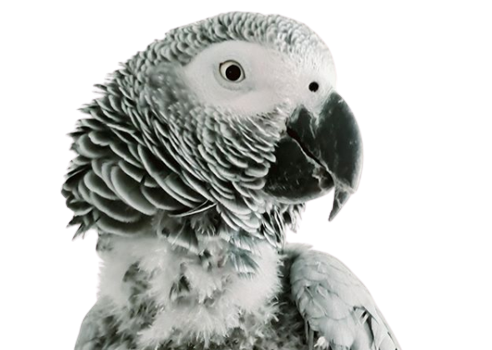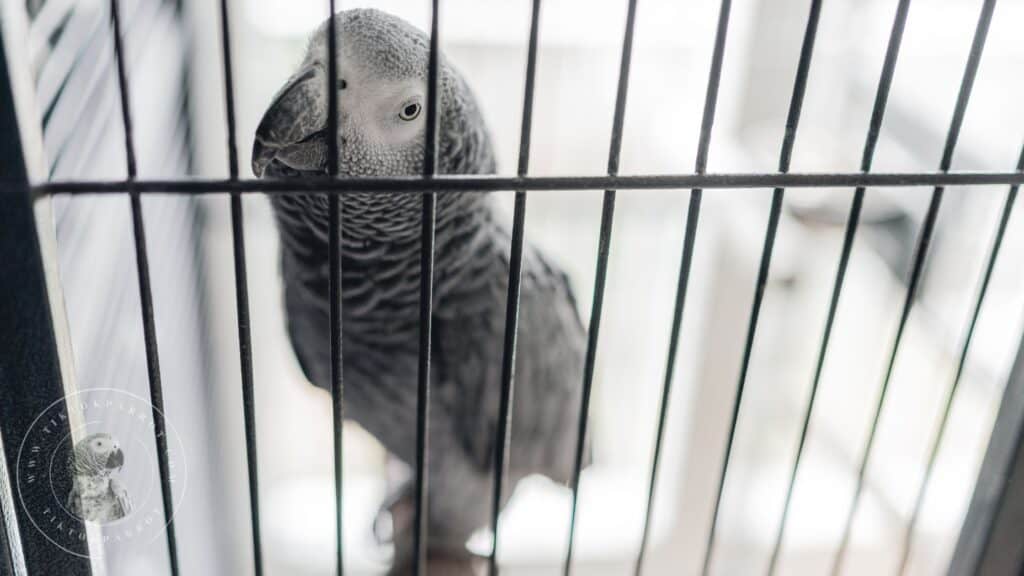Buying your African Grey parrot a cage should take an enormous amount of consideration. This will be your pet’s very own living space in the house, and it’s also important for animals to feel that they are secure.
Discover essential information about an African Grey Parrot’s cage and learn how to create a safe and stimulating environment for your beloved avian companion. Explore the key considerations, FAQs, and expert tips to ensure your African Grey Parrot thrives in its habitat.
You might not be giving it any thought yet, but when you buy an African Grey, take note of the cage from which it is taken. How big is it? How are the food containers situated? How high are the perches? In order to make adjusting easier, it’s a good idea to keep the inside of your parrots as familiar as it can possibly be to your new pet.
Remember that African Greys are relatively large birds, and as such, require equally large cages. Look for cages that are longer than they are tall, as this is a better design for the bird’s exercise and movement. Steer clear of any cylindrically designed cages, as these can be very constricting to an African Grey. Pet experts recommend a minimum size of 36” long, 36” wide, and 40” high.
The cage should have a large cage door, to keep cleaning easier, as well as transfer the parrot in and out of the cage. Also, make sure that you’re familiar with the latch on your cage door. African Greys are known to be quite good at manipulating latches and locks on a cage, so if you feel this might be easy for the bird to do, take no chances and get a padlock.
Look for a cage that has food and water containers that you can fill from the outside, as having to constantly open the cage door to put in food and water bowls can get a little inconvenient after a while. However, most cages already come with this feature, so don’t settle for those that don’t.
The bottom of the cage should be covered with newspapers. Newsprint no longer contains any lead, so at least you don’t have to worry about poisoning your bird in the long run.
When you get a new cage, it’s very likely that the perches inside are smooth wooden dowels. This is all very well, but it’s infinitely better to use rougher perches. You might want to consider replacing the perch with actual cut branches from a eucalyptus, willow, or apple tree. The perch should ideally be 2.5cm in diameter, but it’s also a good idea to vary the thickness of the perches, as this helps improves the parrot’s grip. Keep an eye on the wood; if the bark has been completely removed, the African Grey might slip. Replace the perches regularly.
The location of your cage matters. A cage placed in the middle of the room, where people can walk completely around it will feel unnerving to an African Grey. Ideally, it should be placed in a part of the room where the parrot feels the safest, like in the corner, where it is protected by two sides. Keep the cage in busy rooms, like a living room, but away from places like the kitchen (where there are fumes) and the bedroom (which can get lonely for the parrot).
If you are a new grey owner, below I would explain further and breakdown the important points which you should consider before buying the cage for your beloved pet.
Creating a Home for Your African Grey Parrot
Welcoming an African Grey parrot into your life is an exciting and rewarding experience. These intelligent and charismatic birds require a dedicated space where they can feel secure, exercise, and express their natural behaviors. In this comprehensive guide, we will explore the vital aspects of an African Grey Parrot’s cage, providing you with valuable insights and practical tips to help you set up the perfect habitat for your feathered friend.
Things You Need to Know about an African Grey Parrot’s Cage
An African Grey Parrot’s cage plays a crucial role in ensuring its well-being and overall happiness. Here are the key points you should consider when creating the ideal living environment for your beloved bird:
1. Size Matters: Providing Ample Space for Your African Grey Parrot
It’s essential to choose a cage that offers sufficient room for your African Grey Parrot to move around comfortably. These birds are known for their playful and curious nature, so a spacious cage will provide them with the freedom they need. Ensure that the cage dimensions allow for full extension of wings without obstruction.
2. Bar Spacing: Balancing Safety and Exploration
When selecting a cage, it’s crucial to consider the bar spacing. The gaps between the bars should be narrow enough to prevent your African Grey Parrot from getting its head or body stuck, while still allowing it to explore and observe its surroundings. Opt for bar spacing that is approximately ¾ to 1 inch apart.
3. Material Matters: Choosing the Right Cage Material
African Grey Parrots are highly intelligent and have strong beaks. Therefore, it’s essential to choose a cage made from durable and non-toxic materials. Stainless steel cages are an excellent choice due to their sturdiness, easy maintenance, and resistance to corrosion.
4. Cage Placement: A Calm and Social Environment
The location of your African Grey Parrot’s cage is important for its well-being. Place the cage in an area where your bird can enjoy social interaction with family members, while also ensuring it has a quiet and peaceful retreat when needed. Avoid placing the cage in direct sunlight or drafty areas.
5. Accessories and Enrichment: Creating a Stimulating Environment
To keep your African Grey Parrot mentally stimulated and physically active, it’s vital to provide a variety of toys, perches, and accessories within the cage. Include different textures, puzzles, and chew toys to engage your bird’s natural instincts and prevent boredom.
6. Proper Hygiene: Maintaining a Clean and Healthy Cage
Regular cleaning is essential to ensure your African Grey Parrot’s cage remains hygienic and free from harmful bacteria. Clean the cage and accessories with bird-safe cleaning products, and provide fresh food and water daily. Maintain a routine to prevent the accumulation of waste and promote a healthy environment.
FAQs about an African Grey Parrot’s Cage
These additional FAQs and their answers provide further insights into the important considerations when it comes to an African Grey Parrot’s cage. By addressing these common questions, you can better understand how to provide the best possible living space for your beloved avian companion.
FAQ 1: What is the ideal cage size for an African Grey Parrot?
The ideal cage size for an African Grey Parrot should allow for unrestricted wing movement. A minimum of 36 inches in width, depth, and height is recommended for smaller parrots, while larger African Grey Parrots may require even more space.
FAQ 2: Can I use a wooden cage for my African Grey Parrot?
Wooden cages are generally not recommended for African Grey Parrots as they can easily be chewed through. Opt for stainless steel cages, which are durable and safe.
FAQ 3: Should I cover my African Grey Parrot’s cage at night?
Covering the cage at night can provide your African Grey Parrot with a sense of security and help promote uninterrupted sleep. Use a breathable cover that allows proper ventilation.
FAQ 4: How often should I clean my African Grey Parrot’s cage?
Cleaning the cage and accessories should be done at least once a week. However, spot cleaning should be performed daily to remove any soiled areas.
FAQ 5: What types of toys are suitable for African Grey Parrots?
African Grey Parrots are intelligent and enjoy toys that challenge their problem-solving abilities. Provide a variety of puzzle toys, foraging toys, and chew toys to keep them mentally and physically stimulated.
FAQ 6: How can I prevent my African Grey Parrot from escaping its cage?
Ensure that the cage is securely locked and that the doors and latches are in good working condition. Regularly check for any signs of wear and tear that could compromise the cage’s integrity.
FAQ 7: How should I choose the right perch for my African Grey Parrot?
Choose perches of varying diameters and textures to promote foot health and exercise. Natural wood perches, such as branches, provide a more comfortable and stimulating surface for your parrot’s feet.
FAQ 8: Can I use sandpaper or concrete perches for my African Grey Parrot?
Avoid using sandpaper or concrete perches as they can cause abrasions and foot problems. Stick to natural wood perches to ensure your parrot’s feet remain healthy.
FAQ 9: Should I place a nest box inside my African Grey Parrot’s cage?
Nest boxes are not necessary unless you plan to breed your African Grey Parrot. Providing a nest box without breeding intentions can lead to hormonal behaviors and aggression.
FAQ 10: How can I create a secure environment in the cage to prevent accidents?
Ensure there are no small gaps or openings where your parrot’s head or body could get stuck. Remove any sharp or potentially hazardous objects, and regularly check for loose wires or dangerous materials that your parrot may chew on.
FAQ 11: Can I use mirrors or reflective surfaces inside my African Grey Parrot’s cage?
It’s generally best to avoid mirrors or reflective surfaces in the cage. African Grey Parrots can become overly attached to their own reflection, leading to behavioral issues and decreased social interaction.
FAQ 12: How can I provide privacy for my African Grey Parrot within the cage?
Including a covered area or a small tent-like shelter inside the cage can provide your parrot with a sense of privacy and a quiet place to retreat when it wants to be alone.
FAQ 13: Is it necessary to provide a water bowl and a bathing area in the cage?
Yes, it is essential to provide both a water bowl for drinking and a bathing area for your African Grey Parrot’s hygiene needs. Regular bathing helps keep their feathers clean and in good condition.
FAQ 14: How can I prevent my African Grey Parrot from escaping through the cage bars?
Ensure that the bar spacing is appropriate for your parrot’s size, as African Grey Parrots are skilled at manipulating their bodies. If the spacing is too wide, consider adding mesh or wire panels to prevent escape.
FAQ 15: Should I place food and water bowls at the bottom or the top of the cage?
It is recommended to place food and water bowls at the top of the cage, as it mimics the natural feeding behavior of African Grey Parrots. This positioning also helps prevent debris from falling into the food and water.
FAQ 16: Can I use artificial plants or flowers inside the cage?
Artificial plants and flowers can be used in the cage as long as they are bird-safe and free from toxic materials. Ensure that your parrot cannot chew on them and potentially ingest any harmful substances.
FAQ 17: How can I prevent my African Grey Parrot from getting bored in its cage?
Rotate and introduce new toys regularly to keep your parrot mentally stimulated. Offer toys with different textures, colors, and functionalities to prevent boredom and encourage exploration.
FAQ 18: Is it necessary to provide a separate sleep cage for my African Grey Parrot?
While not mandatory, providing a separate sleep cage can help establish a consistent sleeping routine for your parrot. This cage should be placed in a quiet and dimly lit area to promote uninterrupted rest.
FAQ 19: Can I use a cage cover for my African Grey Parrot at any time other than bedtime?
Yes, cage covers can be used during the day if your parrot needs a quiet and calm environment, such as during illness or times of stress. However, ensure proper ventilation and monitor your parrot’s comfort.
FAQ 20: How long can my African Grey Parrot stay outside the cage each day?
African Grey Parrots require daily out-of-cage time for exercise and social interaction. Aim for a minimum of 2-4 hours outside the cage, allowing your parrot to stretch its wings and explore in a safe environment.
FAQ 21: What type of cage is best for an African Grey parrot?
The best type of cage for an African Grey parrot is a spacious and durable cage made of stainless steel. Stainless steel cages are sturdy, easy to clean, and resistant to corrosion. They also provide a safe and secure environment for your parrot.
FAQ 22: What size cage does an African Grey parrot need?
African Grey parrots require a cage that is large enough to accommodate their active nature. The recommended minimum cage size for an African Grey parrot is 36 inches in width, depth, and height. However, providing a larger cage will give your parrot more space to move around and exercise.
FAQ 23: Do African Grey parrots need large cages?
Yes, African Grey parrots do need large cages. These intelligent and active birds thrive when they have plenty of space to explore and move around. Large cages allow them to stretch their wings, play with toys, and engage in natural behaviors. Providing a spacious environment is essential for the well-being of an African Grey parrot.
FAQ 24: Can African Greys share a cage?
In general, African Grey parrots are best housed individually in their own cages. While some parrots can live harmoniously together, African Greys are known to be more territorial and prone to aggression towards other birds. It is recommended to provide each African Grey with its own cage to ensure their safety and well-being.
My Final Thoughts: A Sanctuary for Your African Grey parrot
Creating the perfect cage for your African Grey parrot is essential for its well-being and overall happiness. By considering the size, bar spacing, material, placement, accessories, hygiene, and other factors discussed in this guide, you can provide a safe, stimulating, and comfortable environment for your beloved avian companion.
Remember, the Things You Need to Know about an African Grey’s Cage are vital for ensuring a fulfilling and enriching life for your feathered friend.
If you found this blog helpful, It would be great if you could share it with your family and friends who might find it useful as well.
For more useful content about African Grey parrots, you can subscribe my site with your email to get notification upon publishing a new blog, the subscribe box you can see on the right side of this page. Also if you get an alert on your web browser while browsing my site, allow it and that will also give you an alert whenever I publish a new blog. 🙂
You might like to read these as well 🙂
The Importance of a Cage for Your African Grey Parrot
Tips for Buying an African Grey Parrot
African Grey Parrot Price & Owning Cost
Understanding Your African Grey Parrot Nature and Type
Shaking Your Tailfeathers: An African Grey Self Harming
Surprising facts about African Grey Parrots
An Avocado Killed My African Grey Parrot
African Grey Parrot Male or Female? (Determine Gender of African Grey)
Stay safe and much love !




